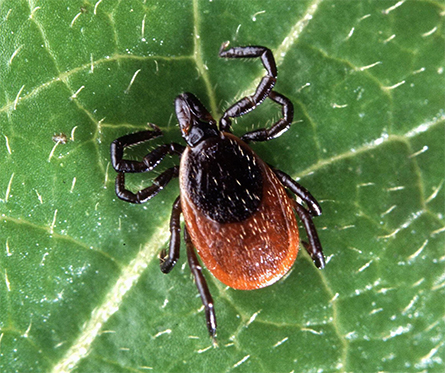Salivary proteins may hold key to targeting tick-borne diseases
When Ingrid Dijkgraaf’s research group was searching for molecules that could inhibit chemokines, a group of small signaling proteins involved in the development of atherosclerosis, they stumbled upon an unusual source: tick saliva.

for Lyme and other diseases.
As blood-sucking parasites, ticks transmit more than a dozen serious diseases, including Lyme disease, typhus and tick-borne meningoencephalitis, to both animals and humans. They also produce proteins in their saliva that help them avoid being spotted by the host’s immune system.
Several years ago, Dijkgraaf’s group, including then–graduate student Stephen Denisov, found that evasins, a family of those proteins that help ticks skirt detection, also could neutralize chemokines involved in atherosclerosis, a buildup of cholesterol plaque that can obstruct blood flow.
“Tick saliva contains chemokine-binding compounds,” said Dijkgraaf, an associate professor of medicinal chemistry and chemical biology at the University of Maastricht. “Millions of years of evolution have already developed, probably, the most ideal compound to target atherosclerosis. This shows how nature could help researchers unravel molecular mechanisms. They can be the starting point for development of therapeutics and chemical agents.”
Dijkgraaf began investigating other proteins in the saliva of ticks. Several years ago, one of her collaborators, Ben Mans, a professor at the University of Pretoria, South Africa, isolated BaSO4-adsorbing protein 1, or BSAP1, from tick saliva and described its anticoagulant activities. However, its structure was yet undetermined, and Dijkgraaf saw this as an excellent research opportunity.
Denisov, by then a postdoctoral fellow in Dijkgraaf’s lab, had extensive experience in structural biology and undertook the project.
“After Dr. Mans gave us the sequence, we were able to synthesize this protein chemically,” Denisov said. “Once we elucidated the structure, we carried out additional studies to characterize its activity.”
Denisov discovered that parts of the BSAP1 protein were similar to others, such as tick salivary lectin complement pathway inhibitor, or TSLPI, Salp14. He carried out assays to distinguish TSLPI Salp14 and BSAP1on a functional level and found that the BSAP1 and TSLP1 proteins both inhibit the lectin complement pathway and thus prevent the host’s immune system from recognizing an invasive tick bite. However, the Salp14 protein has a double function — it is an inhibitor of both the lectin complement pathway and the host coagulation cascade, which means it also prevents clotting of the host’s blood at the site of the bite.
Denisov’s data collectively support a mechanism by which tick saliva proteins can evade the host immune system. The findings recently were published as a research paper in the Journal of Biological Chemistry.
For next steps, Dijkgraaf wants to study the precise molecular mechanism by which the salivary proteins inhibit the host immune system and potentially use these proteins for development of anti-tick vaccines.
Her collaborator Joppe W. Hovius, an infectious disease specialist at the University of Amsterdam, is an expert on the TSLPI protein.
“His work has shown that the TSLPI protein helps Borrelia bacterium to move from the ticks to the host and cause Lyme disease,” Dijkgraaf said. “Hence, if we could inhibit this protein by antibodies or some medication, then maybe we can also inhibit the transmission of the Borrelia bacterium from tick and host.”
Enjoy reading ASBMB Today?
Become a member to receive the print edition four times a year and the digital edition monthly.
Learn moreGet the latest from ASBMB Today
Enter your email address, and we’ll send you a weekly email with recent articles, interviews and more.
Latest in Science
Science highlights or most popular articles

Mining microbes for rare earth solutions
Joseph Cotruvo, Jr., will receive the ASBMB Mildred Cohn Young Investigator Award at the ASBMB Annual Meeting, March 7–10, just outside of Washington, D.C.

Fueling healthier aging, connecting metabolism stress and time
Biochemist Melanie McReynolds investigates how metabolism and stress shape the aging process. Her research on NAD+, a molecule central to cellular energy, reveals how maintaining its balance could promote healthier, longer lives.

Mapping proteins, one side chain at a time
Roland Dunbrack Jr. will receive the ASBMB DeLano Award for Computational Biosciences at the ASBMB Annual Meeting, March 7–10, just outside of Washington, D.C.

Exploring the link between lipids and longevity
Meng Wang will present her work on metabolism and aging at the ASBMB Annual Meeting, March 7-10, just outside of Washington, D.C.

Defining a ‘crucial gatekeeper’ of lipid metabolism
George Carman receives the Herbert Tabor Research Award at the ASBMB Annual Meeting, March 7–10, just outside of Washington, D.C.

The science of staying strong
Muscles power every movement, but they also tell the story of aging itself. Scientists are uncovering how strength fades, why some species resist it and what lifestyle and molecular clues could help preserve muscle health for life.

